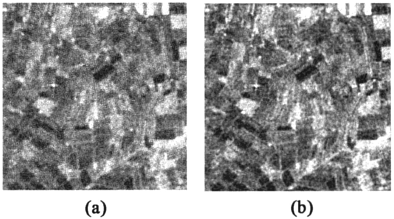277.
| [Cover] [Contents] [Index] |
Page 48
estimated noise-free signal  should be close to the mean of the central pixel’s neighbours (i.e. in the case of k → 0), or should tend to remain near its observed value z (i.e. in the case of k → 1). That is, k determines the amount of smoothing that is applied. Based on Equation (1.47) and keeping Cz fixed, if
should be close to the mean of the central pixel’s neighbours (i.e. in the case of k → 0), or should tend to remain near its observed value z (i.e. in the case of k → 1). That is, k determines the amount of smoothing that is applied. Based on Equation (1.47) and keeping Cz fixed, if  , we can set
, we can set  , hence k will be large. However, if
, hence k will be large. However, if  , it follows that
, it follows that  , in which case k will be small. One can thus infer that the value of k decreases as Cv increases. In the case of an image with a high level of high noise contamination, a large noise coefficient of variation Cv and a large window size are preferred. Figure 1.29 illustrates the effect of different noise coefficients of variation based on Figure 1.27a. Both images, shown in Figure 1.29a and b, are obtained by choosing
, in which case k will be small. One can thus infer that the value of k decreases as Cv increases. In the case of an image with a high level of high noise contamination, a large noise coefficient of variation Cv and a large window size are preferred. Figure 1.29 illustrates the effect of different noise coefficients of variation based on Figure 1.27a. Both images, shown in Figure 1.29a and b, are obtained by choosing  and 2.2, respectively, using a window size of 5×5. The results show that the larger value of
and 2.2, respectively, using a window size of 5×5. The results show that the larger value of  results in greater smoothing (Figure 1.29b).
results in greater smoothing (Figure 1.29b).
1.8.3.2 Lee sigma filter
Lee (1986) proposed a second speckle suppression algorithm, called the sigma filter because it is based on the use of the standard deviation (sigma). The sigma filter is similar to the mean filter described earlier in that it estimates the noise-free signal in terms of an average derived from the central pixel’s neighbours. The difference is that sigma filter only uses pixels within the window whose values lie within a two-sigma range of the mean to perform averaging. This range is related to the noise standard deviation σv. The idea is based on the knowledge that in an ideal Gaussian distribution, around 95% of samples fall within the two sigma range from the mean. Therefore, samples (pixel values) lying outside this range are more

Figure 1.29 Speckle suppression results using (a)  and (b)
and (b)  . Larger values of Cv result in a greater smoothing effect.
. Larger values of Cv result in a greater smoothing effect.
| [Cover] [Contents] [Index] |
EAN: 2147483647
Pages: 354